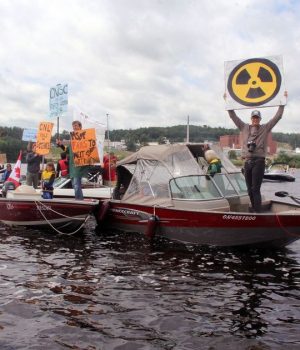ONTARIO (Ottawa) — Civil society groups remain staunchly opposed to two radioactive waste dumps beside the Ottawa River, despite new studies released December 12 by the embattled multinational consortium behind the proposals. Citizens groups and NGO’s say no amount of tweaking by Canadian Nuclear Laboratories can make the proposed projects meet international safety standards.
Announced in 2016, the consortium’s plans to build a giant mound for more than one million tonnes of radioactive waste and to entomb a defunct reactor in concrete along side the Ottawa River have raised the ire of citizens and retired nuclear scientists alike. First Nations, NGOs, federal government departments, the Quebec government, and over 140 municipalities have also weighed in with serious concerns about the proposed projects.
“These proposals violate the principle that radioactive waste must be kept out of contact with the biosphere for as long as it remains radioactive,” according to Ole Hendrickson, a scientist and researcher for the group Concerned Citizens of Renfrew County and Area. “The mound and the tomb are the wrong strategies; they simply can’t do the job of keeping radioactive toxins out of our air and drinking water,” Hendrickson said. “In addition to radioactive materials, both facilities would release heavy metals and toxic organic compounds during and after construction.”
Critics are calling on the federal government to cancel these quick-and-dirty radioactive dumps and step up with funding to support world class radioactive waste storage facilities for Canada’s $8 billion to $10 billion nuclear waste legacy. Ottawa has admitted it has not even formulated a detailed policy on the long-term management of radioactive wastes.
“Radioactive wastes should never be abandoned right beside major water bodies”, says Gordon Edwards, president of the Canadian Coalition for Nuclear Responsibility. “They should be maintained in a monitored and retrievable fashion so that future generations can cope with them. These wastes will be hazardous and radioactive for more than one hundred thousand years, essentially for eternity. They must be carefully packaged and labelled and stored securely, well away from drinking water sources.”
Hendrickson adds that the lack of a careful siting process concerns many citizens groups and NGOs. “It is obvious that the consortium chose the proposed sites based on convenience and low cost, not public safety.”
The proposed facilities do not comply with International Atomic Energy Agency (IAEA) guidelines. The IAEA requires that long-lived radioactive waste be placed in a moderately deep or very deep underground facility. The IAEA also says that flooding a defunct reactor with concrete can only be used in cases of extreme emergency such as a meltdown.
Canadian Nuclear Laboratories misrepresents the amount of long-lived radioactive material that would go in its gigantic five-to-seven story surface mound. The revised environmental impact statement includes a partial inventory of 30 radioactive materials destined for the dump, and 25 of them are very long-lived indeed, each with a half-life of more than four centuries. Of the 30 materials listed, 22 have half-lives over one thousand years, 17 have half-lives over 100 thousand years, and seven have half-lives over one million years. None of these materials would meet the IAEA definition of short-lived waste. Nevertheless, the revised environmental impact statement, released last week by the consortium, asserts only low level waste that “primarily contains short-lived radionuclides” would go into the mound.
“This is a clear example of the ways that CNL misleads the public and decision-makers by playing fast and loose with terms such as “near surface” “low level” and “short-lived”, says Johanna Echlin, of the Old Fort William (Quebec) Cottagers’ Association.
According to Echlin, a federal commitment to create world class facilities for its radioactive waste is urgently needed and would have many benefits.
“We have the expertise in Canada to be a world leader in looking after these radioactive wastes,” Echlin said. “Many well-paying jobs and careers will be created when the government of Canada takes this issue seriously and does the right thing. We can do this. We can keep radioactive waste out of our rivers. We’ll all sleep easier knowing that our health, our property values, the beautiful Ottawa River, and future generations are all protected.”
The proponent of the two nuclear waste dumps, Canadian Nuclear Laboratories is owned by the “Canadian National Energy Alliance”, a consortium of SNC-Lavalin and two Texas-based engineering firms. Canadian Nuclear Laboratories is under contract by the federal government to reduce Canada’s $8 billion federal nuclear waste “legacy” liabilities quickly and cheaply.
Environmental assessments of the giant mound and the reactor tomb are in progress. Licensing hearings for the projects are expected in late 2020.







![Kenopic/Smith Auction [Paid Ad]](https://whitewaternews.ca/wp-content/uploads/2018/10/advertising-100x75.jpeg)

